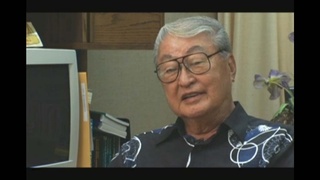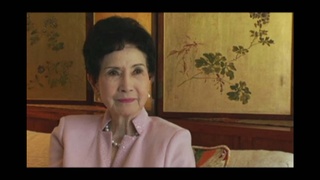Interviews
Helping soldiers
On the grass outside, there weren't even enough blankets for the soldiers. And so all the casualties were lying down on the grass. And one man I remember vividly, he was a young guy, a blond soldier. He must've been 18 or 19. And I was looking after him and he had asked me to write a letter to his mother. So, with only eighth grade education, I couldn't do much. But, he dictated. So I did write the letter for him and he gave me the address to mail the letter. The next morning, I went back to him and he was gone. He passed away that night.
And so, funny how we were really just exposed to all the wartime things. The Army trucks just park in front—our plantation camp was filled with all the trucks and everything. So it scared us, we couldn't go out.
And then, what's funny, two weeks later, I received a letter from Washington D.C. from the Army Department. They had checked our background. They found out that I was an alien. And so they said, We appreciate your support and everything, and You did a good... I still have the letter, you know. And so then, being an alien, I'm sorry but that's about it, you know. And they didn't want me to help anymore. And so I think all my friends, I think, were eliminated from helping. But, that was kind of sad. So, because we grew up during wartime, I think it made it kind of difficult, too. I was considered an alien, I couldn't go out after 6 pm. I couldn't work near Army post. And so, it was kind of difficult for me.
Date: February 19, 2004
Location: Hawai'i, US
Interviewer: Lisa Itagaki, Krissy Kim
Contributed by: Watase Media Arts Center, Japanese American National Museum.
Explore More Videos

Losing job with railroad because of being Japanese American
(b. 1923) Chick sexer

Starting a medical program in Hawai‘i
(b.1925) Sansei, cardiovascular surgeon.

Traveling to Manzanar
(b. 1921) Nisei veteran who served in the occupation of Japan


Victory Corps Work during World War II
(1925 - 2018) Nisei educator from Hawai‘i

Jobs in Manzanar
(b. 1921) Nisei veteran who served in the occupation of Japan

Sugar beet and potato farming in Idaho
(b. 1921) Nisei veteran who served in the occupation of Japan

Recalling Pinedale and Tule Lake concentration camps
Judge, only Japanese American to serve on CWRIC.

Impressions of student relocation in South Dakota
Judge, only Japanese American to serve on CWRIC.

Being called out of Reserves
(b. 1921) Nisei veteran who served in the occupation of Japan

Fort Snelling
(b. 1921) Nisei veteran who served in the occupation of Japan


Attempts to sign up for military service
(1917 - 2004) Political activist

No discrimination in Argentina (Spanish)
(1925-2014) La Plata Hochi, Journalist

Traveling from Manila to Tokyo
(b. 1921) Nisei veteran who served in the occupation of Japan
